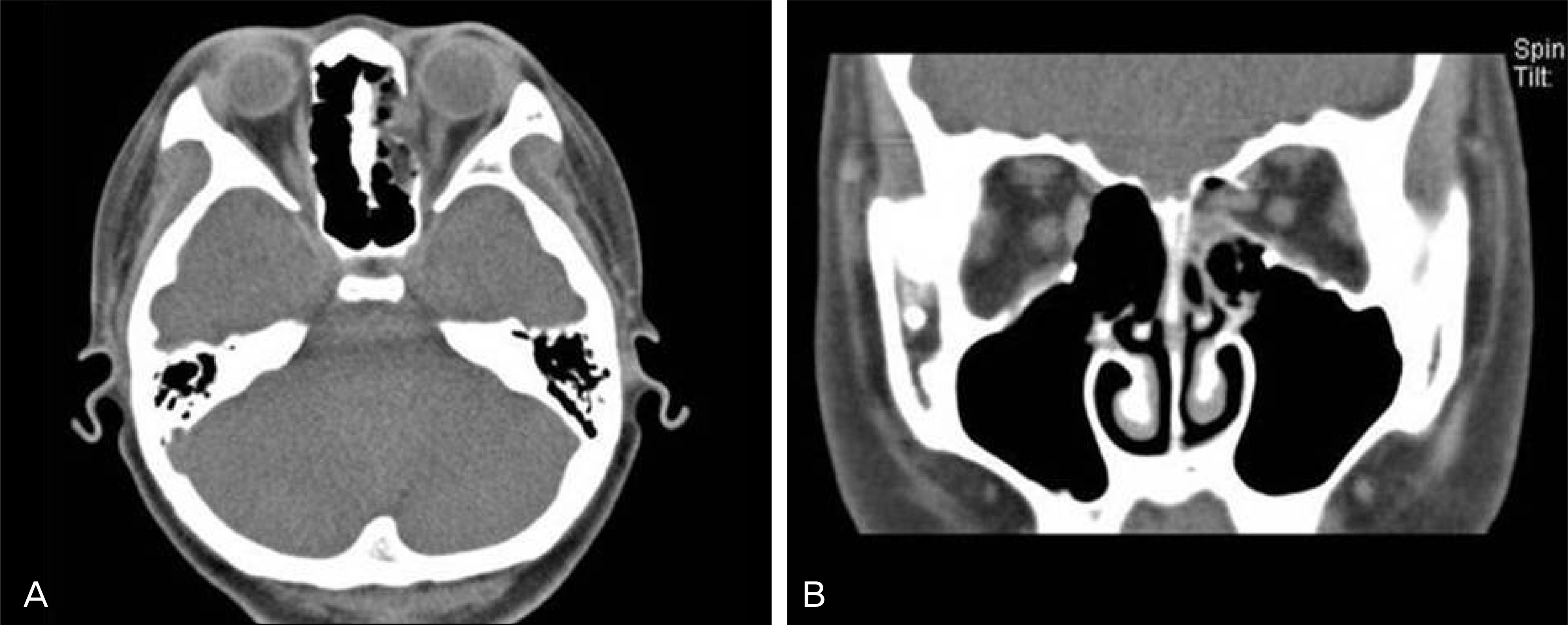J Korean Ophthalmol Soc.
2011 May;52(5):624-627. 10.3341/jkos.2011.52.5.624.
Postoperative Neurogenic Blepharoptosis after Repair of a Medial Orbital Wall Fracture Using the Transcaruncular Approach
- Affiliations
-
- 1Department of Ophthalmology, Chonbuk National University Medical School, Jeonju, Korea. ahnmin@jbnu.ac.kr
- KMID: 2214584
- DOI: http://doi.org/10.3341/jkos.2011.52.5.624
Abstract
- PURPOSE
We report a case of neurogenic blepharoptosis after reconstruction of a medial orbital wall fracture using the transcaruncular approach.
CASE SUMMARY
A 13-year-old girl presented with left eyeball pain and binocular diplopia caused by trauma from falling. Orbital computerized tomography showed a blowout fracture of the left medial orbital wall, herniation of the orbital soft tissue into the ethmoid sinus, and a portion of the medial rectus muscle trapped in the fracture. The patient underwent successful reconstruction of the medial orbital wall using the transcaruncular approach. However, moderate blepharoptosis with functional loss of the levator palpebrae superioris muscle developed immediately after awaking from the anesthesia. The blepharoptosis was presumed to have developed due to postoperative edema; therefore, oral corticosteroid was prescribed. However, the blepharoptosis did not improve. No other ocular signs or symptoms were detected. Because neither the margin reflex distance (MRD1) nor the function of the levator palpebrae superioris muscle recovered after eight weeks of conservative treatment, surgical correction of blepharoptosis was performed under local anesthesia. The preaponeurotic fat, soft tissue, tarsal plate, and aponeurosis of the levator palpebrae superioris all appeared normal. The patient underwent maximal resection of the levator palpebrae superioris muscle and the blepharoptosis was alleviated two weeks after the operation.
MeSH Terms
Figure
Reference
-
References
1. Shorr N, Baylis HI, Goldberg RA, Perry JD. Transcaruncular approach to the medial orbit and orbital apex. Ophthalmology. 2000; 107:1459–63.
Article2. Garcia GH, Goldberg RA, Shorr N. The transcaruncular approach in repair of orbital fractures: a retrospective study. J Craniomaxillofac Trauma. 1998; 4:7–12.3. Suga H, Sugawara Y, Uda H, Kobayashi N. The transconjunctival approach for orbital bony surgery: in which cases should it be used? J Craniofac Surg. 2004; 15:454–7.
Article4. Paris GL, Quickert MH. Disinsertion of the aponeurosis of the levator palpebrae superioris muscle after cataract extraction. Am J Ophthalmol. 1976; 81:337–40.
Article5. Song MS, Shin DH, Spoor TC. Incidence of ptosis following trabeculectomy: A comparative study. Korean J Ophthalmol. 1996; 10:97–103.
Article6. Malhotra R, Saleh GM, de Sousa JL, et al. The transcaruncular approach to orbital fracture repair: ophthalmic sequelae. J Craniofac Surg. 2007; 18:420–6.7. Jung JW, Chi MJ. Temporary unilateral neurogenic blepharoptosis after orbital medial wall reconstruction: 3 cases. Ophthalmologica. 2008; 222:360–2.
Article8. Yeh S, Foroozan R. Orbital apex syndrome. Curr Opin Ophthalmol. 2004; 15:490–8.
Article9. McAvoy CE, Lacey B, Page AB. Traumatic superior orbital fissure syndrome. Eye. 2004; 18:844–5.
Article10. Eo S, Kim JY, Azari K. Temporary orbital apex syndrome after repair of orbital wall fracture. Plast Reconstr Surg. 2005; 116:85e–9e.
Article11. Acartürk S, Seküçoğ lu T, Kesiktäs E. Mega dose corticosteroid treatment for traumatic superior orbital fissure and orbital apex syndromes. Ann Plast Surg. 2004; 53:60–4.12. Chen CT, Wang TY, Tsay PK, et al. Traumatic superior orbital fissure syndrome: assessment of cranial nerve recovery in 33 cases. Plast Reconstr Surg. 2010; 126:205–12.
Article
- Full Text Links
- Actions
-
Cited
- CITED
-
- Close
- Share
- Similar articles
-
- Repair of Orbital Wall Fracture Using Transcaruncular Approach
- Transcaruncular Approach to Blowout Fractures of the Medial Orbital Wall
- The transcaruncular approach of the medial orbital wall fracture
- Transcaruncular Approach for Reconstruction of Old Medial Orbital wall Fracture
- Reconstruction of Isolated Medial Orbital Wall Fracture Using a Transcaruncular Approach



